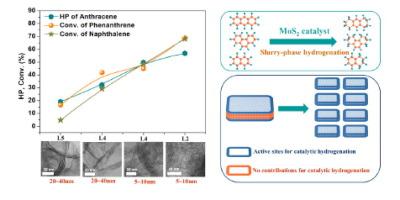Journal of Energy Chemistry ( IF 13.1 ) Pub Date : 2021-09-06 , DOI: 10.1016/j.jechem.2021.08.053 Donge Wang 1 , Jiahe Li 1 , Huaijun Ma 1 , Chenggong Yang 1, 2 , Zhendong Pan 1 , Wei Qu 1 , Zhijian Tian 1, 3

|
Slurry-phase hydrogenation technology is the frontier topic in the efficient conversion of heavy oils into light fractions around the world. Developing highly active dispersed MoS2 catalysts is the major obstacle to realize the industrial application of upgrading heavy oils. In this work, both top-down ball-milling method and bottom-up hydrothermal method were designed to synthesize MoS2 catalysts with controllable layer structures. The stacking layers and lateral sizes for micro-scaled MoS2 catalysts by ball-milling method can be reduced to their limits and stabilize at 6∼8 layers and lateral size of ca. 30 nm. The more flexible bottom-up hydrothermal method can construct MoS2 catalysts with much smaller lateral sizes and fewer stacking layers, especially, MoS2 catalyst fabricated with ammonium tetrathiomolybdate as Mo and S precursor possesses average stacking layers of 2 and lateral size of 5∼10 nm. Polycyclic aromatic hydrocarbons anthracene, phenanthrene and naphthalene were used as model compounds of heavy oils to investigate the catalytic hydrogenation performance of designed MoS2 catalysts. The catalytic activities of MoS2 catalysts can be well correlated with their stacking layers and lateral size. The edges of top and bottom S-Mo-S atomic layers for MoS2 sheets, named rim sites, are positively correlated with the exposure of active sites for catalytic hydrogenation of PAHs. The highest catalytic activity of MoS2 catalyst results from its layer structures of 100% rim sites and the smallest lateral size of 5∼10 nm, which is beneficial to expose maximum active sites for catalytic hydrogenation reactions. This work can guide us to design the highly active hydrogenation catalysts, and promote the industrial application of upgrading heavy oils.
中文翻译:

用于多环芳烃淤浆相加氢的层状结构可调二硫化钼催化剂
浆相加氢技术是世界各国将重油高效转化为轻质馏分的前沿课题。开发高活性分散MoS 2催化剂是实现重油改质工业化应用的主要障碍。在这项工作中,自上而下的球磨法和自下而上的水热法被设计用于合成具有可控层结构的MoS 2催化剂。通过球磨法制备的微型MoS 2催化剂的堆叠层数和横向尺寸可以降低到极限并稳定在6~8层和约1000μm的横向尺寸。30 纳米。更灵活的自下而上的水热法可以构建MoS 2横向尺寸小得多且堆积层数少的催化剂,特别是以四硫代钼酸铵为Mo和S前驱体制备的MoS 2催化剂,平均堆积层数为2,横向尺寸为5~10 nm。以多环芳烃蒽、菲和萘作为重油的模型化合物,研究了设计的MoS 2催化剂的催化加氢性能。MoS 2催化剂的催化活性与它们的堆积层和横向尺寸密切相关。MoS 2的顶部和底部 S-Mo-S 原子层的边缘称为边缘位点的薄片与多环芳烃催化氢化活性位点的暴露呈正相关。MoS 2催化剂的最高催化活性源于其100%边缘位点的层状结构和5~10 nm的最小横向尺寸,这有利于暴露催化加氢反应的最大活性位点。这项工作可以指导我们设计高活性加氢催化剂,促进重油改质的工业应用。



























 京公网安备 11010802027423号
京公网安备 11010802027423号